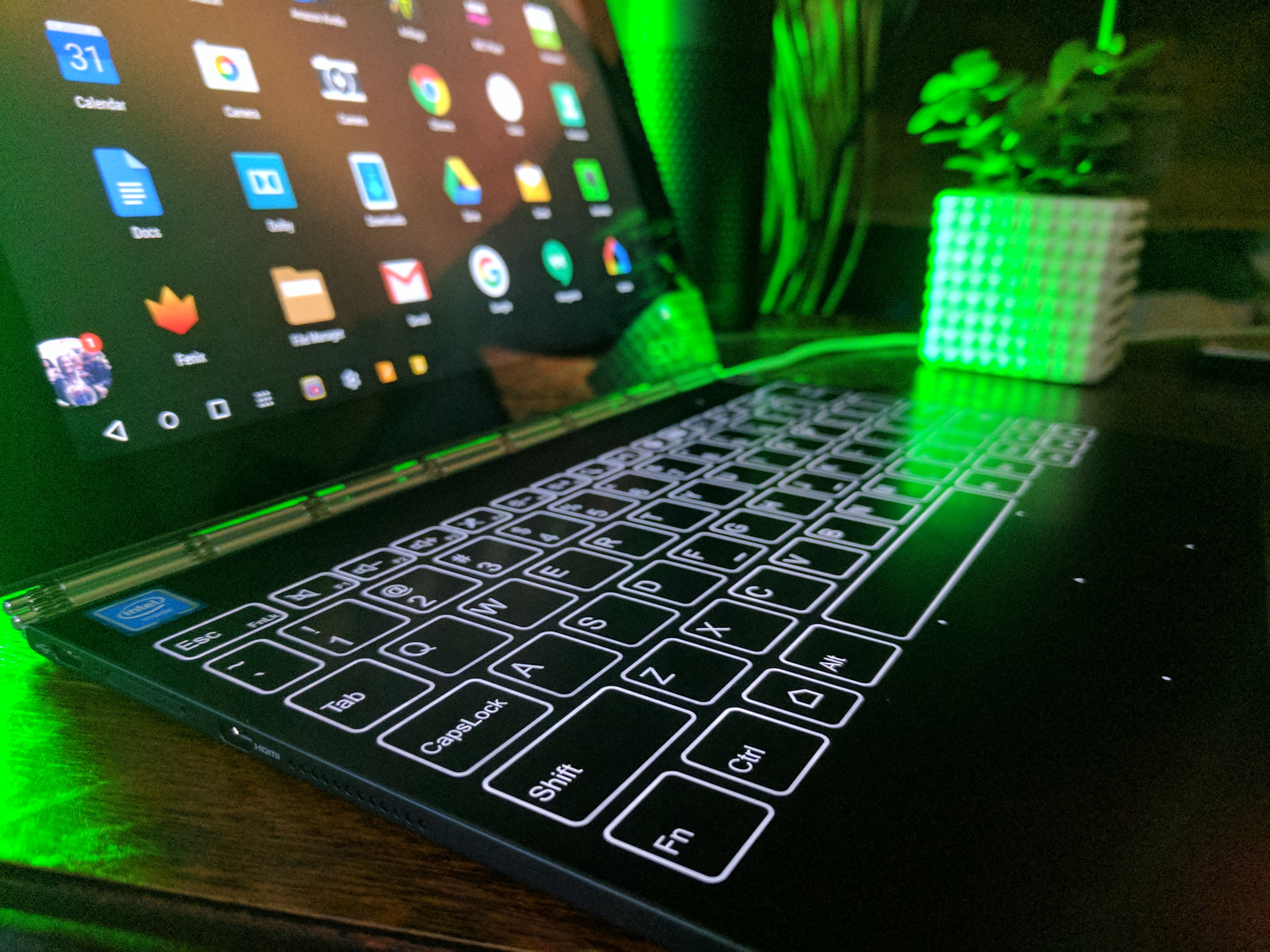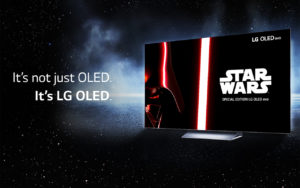‘The best Android tablet you (probably) shouldn’t buy.’
Lenovo’s Yogabook (£450) is an excellent device for anyone who already uses Wacom’s illustration technology to digitize drawings, notes and diagrams. However, it falls short of showing how hybrid Android devices could be a viable alternative to mainstream laptop OSs.

[ad#co-1]
THE HARDWARE
The Yogabook looks premium, stylish, and well made. And for the most part, it is. The casing is well-built, but a little creaky. It is not enough to put me off, however, it was something that I noticed every time I used the YB in its laptop orientation. Similarly, when you pick it up by the keyboard the shell sometimes gives an audible response – this is a shame, as it immediately makes the tablet feel less premium than it looks.

The clockwork hinge is a beauty to behold. It’s smooth and solid, and according to the tastes of my friends and family, it looks anywhere from interesting to ridiculous to beautiful. I can’t say how well it will age, the small gears could potentially get clogged up with use but time will tell. My main complaint with the hinge is that when you have the YB in laptop mode there is a slight give to the screen. It’s no more than you get on other hybrid devices, but it’s still a cause for mild irritation. To solve this I tend to use the YB in the tent orientation, which is completely solid and works well for gaming, and browsing either at a table, seated or in bed.
The screen is a 10.10 inch, 1200 by 1920 pixel affair which looks just about ok. It is fairly bright and has viewing angles slightly above average. It is ample for reading and consuming media so long as you are not in bright sunlight. However, put the YB next to an iPad mini and you will quickly notice the difference. And this is one of the recurring issues with the YB – it does “just fine” in so many categories that it is hard to justify the price point.
It has two cameras, an 8-Megapixel shooter on the rear, and a 2-Megapixel sensor on the front. Considering that the main use for a tablet’s camera is for video messaging (or at least in my use case) it’s annoying that the back camera was beefed up in favour of the front facing snapper. I still don’t see the use case for using a tablet camera to take photos when everyone has a smartphone, but video calling from a tablet, especially one that can be used like a laptop, a tent, and standard tablet, is a core feature. Video quality from the 2-MP camera is usable is good light, but in low light, it starts to really struggle. And the 8-MPsensor on the back is hardly much better, it produces noisy photos with poor automatic iso settings.
The Yogabook also supports expandable storage via SD card, as well as 3G/4G with a nano sim.

THE KEYBOARD
The Wacom tablet/keyboard hybrid on the Yogabook is where the device starts to define itself. The keyboard looks great when it is on, the illuminated keys are somewhere between Tron and Tony Stark. It’s slick; the keys look more like glowing e-ink then back lit, and manage to look stylish and understated rather than gaudy. My only issue with the aesthetics of the keyboard is that when it is turned off you can still see the unlit outlines of the keys. It’s a small issue but it ruins the illusion that a clean panel of glass has just transformed into a keyboard. It also means that the potential the keyboard is limited. If it was truly digital you would be able to load up different configurations and languages. This would add some serious value to the Yogabook, taking advantage of the potential of a dynamic physical keyboard, where it currently feels like an experiment.
Typing on the keyboard takes a little getting used to. By default, the Yogabook will provide haptic feedback to match each keystroke, as well as making a sound to simulate a keypress. The physical feedback is useful, as it makes the typing experience feel more tangible and precise. However, there is a slight lag to it, which becomes more obvious the quicker you type. The audible feedback is equally out of sync and is incredibly annoying, but at least you can turn it off in the settings. After playing with the settings I ended up turning off both the haptic and audible feedback, in favour of just staring at my hands as I typed.
Typing on the Yogabook is never going to be as fast or as accurate as typing on a laptop. But, for short bursts of text, like replying to a Facebook message, or taking down a shopping list, it beats writing with the onscreen keyboard on a tablet. Having the onscreen suggestions popping up on-screen works well, providing a practical blend of onscreen and offscreen input. As the screen is capacitive, bear in mind that if you have long nails it won’t pick up contact with them. Because the keyboard is separate you get a full, unimpeded view of your apps. The light up keys look slick, especially in the dark. Like typing with a MacBook, once you get used to light-up keys you can’t go back to normal keys. Overall the keyboard has a lot of potential, but it isn’t a replacement for the one on your laptop.
Then we get to the trackpad. In short – it isn’t very good. You can’t scroll webpages or apps with multi-touch gestures, and the scrolling which requires a light tough and a sweep is inconsistent, to say the least. You can just about use the tracking to select apps from your homescreen, but forget about using it to navigate webpages or anything else that requires scrolling. Obviously, the advantage to a hybrid device is you can just use the touch screen to navigate on-screen menus, but as a demonstration of Android as an alternative OS to OSX or Windows, it’s disappointing.

However, from the bad to the good – the Wacom stylus that comes with the Yogabook is brilliant. As a stylus it could feel a little more premium however, it is light-weight and comfortable to hold, and I love that it looks like an actual pen. It won’t work as a stylus on the Yogabook’s screen, but long press the circular button above the keyboard and the whole thing becomes a Wacom illustration tablet. If you are used to drawing with a Wacom tablet in Illustrator or any other app you will immediately feel at home. Input is smooth, and the pressure sensitivity is on point. There is a slight lag that you quickly get used to, but could be cleaned up. That being said, this is the best drawing experience I’ve had on a tablet, as I much prefer being able to draw on the Wacom, and have an unimpeded view of the screen.
The stylus also allows you to remove the nib and replace it with a ‘real pen’ stylus. This allows you to write in a notebook that clips magnetically to the Yogabook, automatically digitizing your notes. The best thing with this is that you don’t have to use the included notebook. You can use your own, or just a piece of paper. If you’re a student or work in a profession where you take short-hand or a combination of text and visual notes, this feature is invaluable. You can take down physical notes in any form and then digitise them in real time. And the included notebook app is one of the best-preloaded apps on the tablet.
THE SOFTWARE
Android is in need of an overhaul when it comes to the software side of tablets. The stock interface is stale but easily fixed with any one of a number of custom launchers. Split screen mode doesn’t work for a surprising number of stock Google apps, let alone other apps in the Playstore.
Having your running apps in the navigation bar works well, and makes app swapping quicker and more efficient. It is almost there, but the like the hardware of the Yogabook, it isn’t quite there yet.
The experience of using an Android tablet has never quite been good enough to make me consider using one as an everyday productivity tool. The nexus 7 was the only Android tablet I would really recommend to friends and family, partly because of the price point, and partly because it’s size made it the perfect tool for consuming media and casual gaming. However, if I am going to be spending upwards of £490 for a tablet, I want it to be more than a glorified e-reader, gaming device and media player – I want to be able to use it for productivity and work. And this leads me to the burning issue – should you shell out £490 for a yearbook? In a word, no. If you could pick one up for £250 then maybe. But at the current price point, there are better options out there.
OVERALL
That being said, I’ve enjoyed using the Yogabook and I will miss it when I return it to Lenovo. The hardware isn’t perfect, but it stands out. The hinge is awesome, the keyboard is a head turner, and the real pen input is novel with a lot of potential. Equally, the Wacom support is invaluable if you do a lot of mobile sketching or note taking this is the best device for digitising large amounts of written or drawn content. For a small bunch of people, artists, illustrators, engineers, the Yogabook fills a niche that nothing else does. However, for the general user Lenovo have a way to go before making their laptop/tablet android hybrid a must have device.




